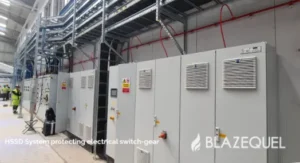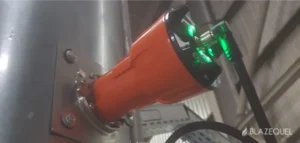
Video Smoke and Video Fire Detection
Ensuring safety in high-risk and operations-critical zones is paramount, and a trustworthy fire detection system plays a crucial role in
Home / Fire Detection and Alarm Systems / Fire Detection Methods / Fire Detection Thermal Camera
Fire is a serious threat to businesses, affecting everything from assets to staff safety. Thermal Fire Detection allows you to provide proactive Shielding against fire hazards is crucial. While traditional detection systems work, new tech like thermal cameras enhances early detection, a game-changer in fire safety
A thermal camera, also called an infrared camera or thermographic camera, works by sensing heat patterns instead of regular light. It captures the heat given off by objects and turns it into a picture where temperature differences show up as different colors. This helps quickly spot areas that are hotter than normal.
In fire detection, it can highlight overheating machinery or electrical devices that might cause potential fire hazard. It’s also handy for spotting fires early on, making it a great tool for fire safety.
Thermal camera systems can be programmed to raise the alarm when a range of pre-defined ‘danger’ heat thresholds have been triggered, and some systems can even trigger the alarm if an unusually rapid rate of rise in temperature is noticed.
Thermal imaging cameras play a crucial role in modern fire detection systems, offering several advantages over traditional methods:
Fire Detection Thermal Camera uses thermal imaging to monitor for temperatures that show signs of a fire or developing fire risk. This technology proves highly effective in various settings, including:
In such environments, internal hotspots can gradually escalate in temperature, signaling a potential fire outbreak. Unlike reactive fire detection methods, thermal imaging enables proactive measures to anticipate fire incidents.
Your thermal fire detection system can also be integrated into a specialized water cannon system enables immediate fire suppression or hotspot cooling. This innovative integration ensures swift mitigation of fire risks, addressing them as soon as they arise, rather than relying on heat-activated sprinkler systems.
At Blazequel we are experts in thermal camera systems and their installation, maintenance and monitoring. We are a BAFE accredited, meaning we perform to the very highest and latest industry standards. Trusted by the leading organizations in the UK. Contact us today at +44 1234 357357 for more information or simply fill in the form below.
The cost of these cameras isn’t the same for every place. It depends on things like how big the place is, how many cameras are needed, and what kind of cameras they are. Whether you want the cameras to be watched remotely or not also affects the cost. To find out how much it would cost for your place, just contact us and we’ll give you a free quote.
Thermal cameras use advanced algorithms to distinguish between genuine fire threats and false alarms caused by heat sources unrelated to fires, such as sunlight, hot machinery, or vehicle exhaust. These algorithms help minimize false alarms and improve the reliability of the system.
Environmental factors such as weather conditions (e.g., fog, rain, snow), atmospheric interference, and obstructions (e.g., smoke, vegetation) can affect the performance of thermal cameras. Additionally, extreme temperatures or high humidity levels may impact the camera’s effectiveness.
The system uses specialized software algorithms designed to identify patterns indicative of fires. These algorithms analyze temperature variations, movement patterns, and other relevant factors to detect and alert users to potential fire hazards.
Yes, thermal cameras can be integrated with other security or surveillance systems, such as CCTV (Closed-Circuit Television) cameras, access control systems, and perimeter security solutions.
The installation process for a thermal camera system involves mounting the cameras in strategic locations, connecting them to power and network infrastructure, and configuring settings and parameters according to the specific requirements of the application. Professional installation services may be available depending on the vendor. Contact us for more information.
Yes, thermal cameras are suitable for both indoor and outdoor use. They can be deployed in various environments, including industrial facilities, commercial buildings, forests, and urban areas
Don’t hesitate to reach out to us, or you can easily fill out the form below. We’re here to assist you.


Ensuring safety in high-risk and operations-critical zones is paramount, and a trustworthy fire detection system plays a crucial role in

High Sensitivity Smoke Detection (HSSD) systems are excellent for protecting high risk, high value environments where early detection is essential.

In many high-risk processes, a spark can be created with alarming ease. Spark detection can help prevent the risk of
